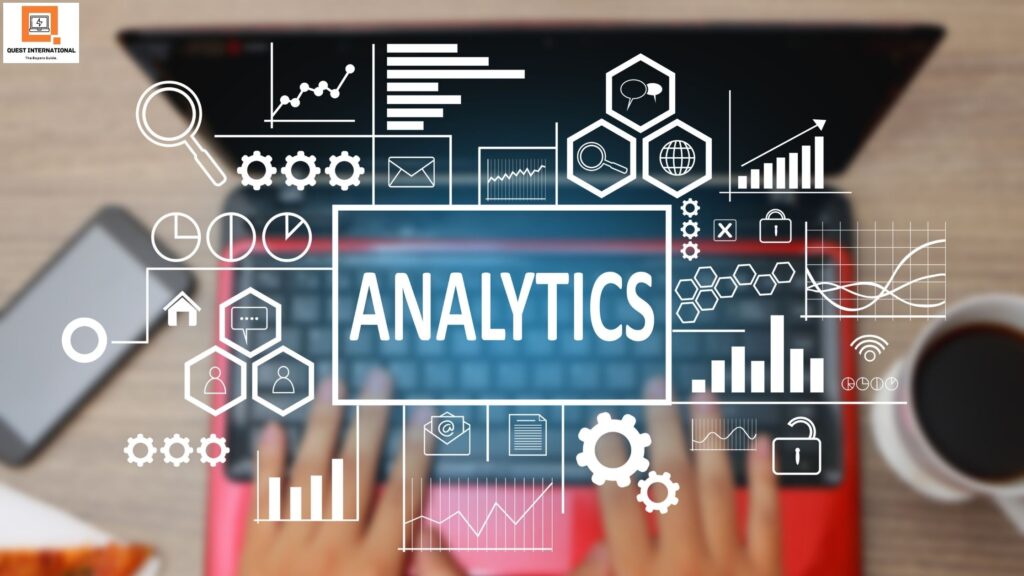Data is king in the modern digital world. Understanding and utilizing the potential of data analytics in digital marketing is essential for everyone, including small-business owners, marketing professionals, and those wishing to launch a career in the field. Making data-driven decisions is essential to the profitability of your marketing campaigns since the world of digital marketing is continuously changing.
We will look at the fundamentals of digital analytics in digital marketing, explain important ideas, and offer helpful pointers for getting started in this beginner’s guide.
What is Digital Analytics?
Digital analytics is the process of collecting, analyzing, and interpreting data from various digital platforms and channels to gain insights into user behavior, online performance, and the effectiveness of marketing campaigns. This information helps marketers make informed decisions and optimize their strategies to achieve specific business goals.

The Importance of Digital Analytics in Digital Marketing
Why is digital analytics so important in the world of marketing? Here are a few key reasons:
1. Informed Decision-Making
Data analytics in digital marketing provides marketers with actionable insights. It allows you to see what’s working and what’s not, helping you make informed decisions about where to allocate your resources for the best results.
2. Improved Targeting
Understanding your audience’s behavior and preferences allows you to tailor your marketing efforts to specific demographics, interests, and needs. This leads to more effective targeting and higher conversion rates.
3. Campaign Optimization
Digital analytics enables you to track the performance of your marketing campaigns in real time. You can make adjustments on the fly, optimizing your campaigns for better results and a higher return on investment (ROI).
4. Competitive Advantage
By leveraging data analytics, you can stay ahead of the competition. You’ll be able to identify trends, spot opportunities, and react faster to changes in the market.
Key Concepts in Digital Analytics

1. Data Collection
The first step in digital analytics is collecting data from various sources, such as websites, social media platforms, email campaigns, and mobile apps. This data can include user interactions, website traffic, click-through rates, conversion rates, and more.
2. Data Analysis
The task that follows data collecting is data analysis. This includes looking at the data to find trends, correlations, and patterns. Data analytics in digital marketing can be done manually or with the help of specialized software and algorithms.
3. Key Performance Indicators (KPIs)
Key Performance Indicators (KPIs) are defined metrics that serve as quantifiable benchmarks, enabling you to assess and quantify the degree of success achieved through your marketing initiatives. These metrics provide crucial insights into campaign performance and guide strategic decisions.
4. A/B Testing
A/B testing, also known as split testing, involves comparing two versions of a webpage or marketing campaign to determine which one performs better. This allows you to make data-driven decisions about design, content, and messaging.
5. Attribution Modelling
Attribution modeling aids in comprehending the customer’s path and the varying touchpoints’ roles in driving conversions. It helps answer questions like Which marketing channels are driving the most conversions? How do users move through the sales funnel?
Digital Analytics Tools
To effectively implement Data analytics in digital marketing, you’ll need the right tools. Here are some popular tools and platforms commonly used in the industry:
1. Google Analytics: Google Analytics is a free and powerful tool that provides detailed insights into website traffic, user behavior, and conversions. It’s a must-have for any digital marketer.
2. Google Tag Manager: This tool allows you to manage and deploy tracking codes and tags on your website without needing to edit the site’s code directly. It simplifies the process of collecting data from various sources.
3. Adobe Analytics: Adobe’s analytics platform offers advanced features for tracking and analyzing user interactions across digital channels. It’s suitable for larger enterprises with complex analytics needs.
4. Mixpanel: Mixpanel specializes in event-based analytics, making it a valuable tool for understanding user interactions within web and mobile applications. It’s particularly useful for app marketers.
5. Facebook Analytics: If you’re running Facebook ad campaigns, Facebook Analytics provides insights into user behavior on the platform. It can help you understand how users interact with your ads and pages.
Getting Started with Digital Analytics
Now that you have a basic understanding of digital analytics, here are some steps to help you get started:

1. Set Clear Goals
Begin by defining your marketing goals. What are your objectives for your digital marketing endeavors? Whether it’s increasing website traffic, boosting sales, or growing your email subscriber list, having clear goals will guide your analytics efforts.
2. Install Tracking Codes
Implement tracking codes (e.g., Google Analytics tracking code) on your website and digital assets. These codes allow you to collect data on user interactions and website performance.
3. Define Key Metrics
Determine the key performance indicators (KPIs) that are in sync with your objectives. These metrics will serve as benchmarks for evaluating the success of your campaigns.
4. Collect and Analyze Data
Start collecting data from your digital channels. Use analytics tools to track user behavior, monitor traffic sources, and assess the effectiveness of your campaigns. Consistently examine and scrutinize the data to acquire valuable insights.
5. Conduct A/B Testing
Experiment with different elements of your marketing campaigns, such as headlines, images, and calls to action. Perform A/B tests to establish which variations yield superior results.
6. Create Reports
Generate reports and dashboards to visualize your data and share insights with your team or clients. Reporting tools within analytics platforms can help streamline this process.
7. Iterate and Optimise
Take advantage of the knowledge you obtained from your data to enhance your marketing efforts and make wise judgments. Refine your campaigns often to get better outcomes over time.
Conclusion
In the ever-evolving landscape of digital marketing, the role of data analytics in digital marketing and digital analytics in marketing is paramount. As we traverse the digital age, the ability to leverage the power of data analytics has become a defining factor in the success of businesses, both large and small. This beginner’s guide has illuminated the fundamental concepts and practices, providing a solid foundation for anyone looking to enter the world of data-driven decision-making.
Digital analytics isn’t just about numbers; it’s about informed decision-making. By understanding user behavior, tracking online performance, and gauging the effectiveness of marketing campaigns, businesses can optimize their strategies to align with specific goals. Informed decisions backed by data empower marketers to allocate resources efficiently for optimal results, improving targeting, campaign optimization, and ultimately, gaining a competitive edge in the market.
As you delve into the realm of Data analytics in digital marketing, remember that it’s a dynamic field where continuous learning and adaptation are key. By following the principles laid out in this guide—such as establishing clear goals, incorporating tracking codes, specifying key metrics, and consistently conducting analysis—you can not only navigate the intricate digital terrain but also maintain a competitive edge. Digital analytics is your compass in the digital marketing landscape, guiding you toward success and innovation.




